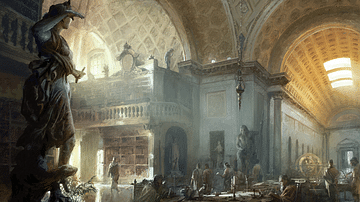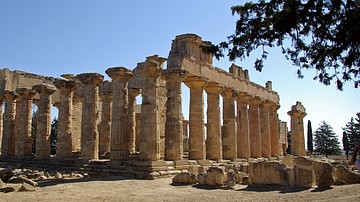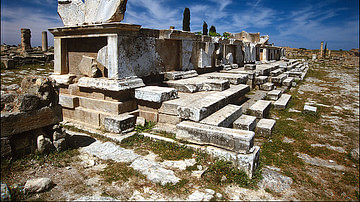
Callimachus of Cyrene (l. c. 310-c. 240 BCE) was a poet and scholar associated with the Library of Alexandria and best known for his Pinakes ("Tablets"), a bibliographic catalog of Greek literature, his poetry, and his literary aesthetic which rejected the epic in favor of shorter works and influenced the later development of Roman literature.
He is considered one of the greatest poets of antiquity, and, through his influence on Roman writers, set the course for Western literary development, especially through his emphasis on brevity and simplicity of form. Among his best-known quotes is "A big book is a big bore," by which he seems to have meant that "less is more" and one should strive to tell one's story as directly and succinctly as possible. Although much has been made of his rejection of Homer, it seems this has been sensationalized. He rejected the standard of literature Homer had come to define but not necessarily the work itself. A similar case could be made for his relationship with the works of Plato, but both authors clearly influenced his own works.
He was never the head of the Library at Alexandria, though this is often claimed, but he may have been the teacher of Apollonius of Rhodes (l. 3rd century BCE), the head librarian after Zenodotus (l. 3rd century BCE) the first librarian at Alexandria. The alleged feud between Callimachus and Apollonius seems to have also been sensationalized and is based on interpretations of fragments of their works as almost nothing is known of the lives of either of them. Apollonius was succeeded as librarian by Eratosthenes (l. c. 276-195 BCE), who may have also been a student of Callimachus.
Although few of his works have survived, he is referenced extensively by later writers who praise his economy of prose and emphasis on an emotional response to personal experience in his poetry. His influence on later writers was enormous, including such notables as Horace, Propertius, Ovid, and Virgil. The details and essential character of his literary aesthetic are still debated today, but not its influence on Western literature.
Family & Early Life
Almost nothing is known of Callimachus' life and most biographical information comes from the Suda (10th century CE), not from his works or those of his contemporaries. He was born to an upper-class family of Cyrene in North Africa and refers to himself as a "son of Battus", meaning Battus I (r. c. 631 to c. 599 BCE), founder of the city of Cyrene and the Battiad Dynasty that developed the surrounding region of Cyrenaica. Callimachus most likely means this reference simply to establish that he is from Cyrene, it does not necessarily mean, as some have claimed, that he was related to the royal house. Scholars Benjamin Acosta-Hughes and Susan A. Stephens give a brief glimpse of his family:
His grandfather, also named Callimachus, was probably the Cyrenean general. Callimachus' sister, Megatima, seems to have married into a high-ranking Cypriot family. A great-grandfather has been identified as Anniceris, a Cyrenean, who, according to an anecdote preserved in Lucian and Aelian, tried to impress Plato by driving his chariot (bound for the Olympic Games) around the periphery of the Academy. Anniceris must have been a man of considerable wealth because he was also said to have ransomed Plato from Dionysius of Syracuse. (4)
Little else is known of Callimachus' early life except that his mother was also named Megatima, he seems to have been educated in Cyrene, and he was living and writing in Alexandria under the reign of Ptolemy II Philadelphus (282-246 BCE). Acosta-Hughes and Stephens write:
Callimachus lived the majority of his adulthood during the reign of the second Ptolemy, the period when the Ptolemaic empire was at its height. The Suda tells us that he was an elementary schoolmaster in Eleusis, but if he is already writing for the court in the late 280's BC, his academic career must have been quite brief. In contrast, Tzetzes records that he was a "youth of the court", an official status that is incompatible with elementary school teaching but would fit with a poetic career that seems to have begun in his early twenties. The easiest explanation for the Suda's information is that it was extrapolated from poems in which Callimachus speaks of the schoolroom or schoolmasters. (3)
As a "youth of the court" and later court poet, Callimachus wrote works for Ptolemy I Soter (r. 323-282 BCE), Ptolemy II, and Ptolemy III Euergetes (r. 246-222 BCE). He most likely arrived in Alexandria from Cyrene toward the end of the reign of Ptolemy I. Although it seems he was associated with the Library of Alexandria under Ptolemy II, his position is unclear. He was never the head librarian, and there is no evidence he was involved in acquisitions.
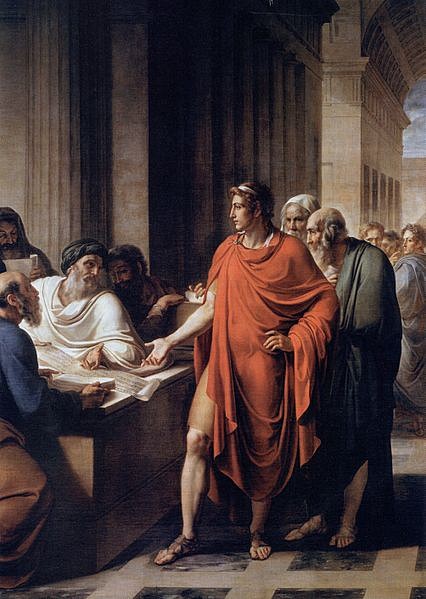
Works
According to the Suda, Callimachus wrote over 800 works. All of his prose has been lost and is only known through references in the works of others. Among those no longer extant are his Marvels Organized by Location – a collection of paradoxes – and his Pinakes. Contrary to popular belief, the Pinakes was not a catalog of the works held by the Library of Alexandria but a bibliographic inventory of all Greek literature, dividing it into poetry and prose and listing author, other works by the same writer, and biographical information. The first "card catalog" of the Library of Alexandria was created by Zenodotus, as noted by scholar Lionel Casson:
Alphabetical order as a mode of organization. So far as we know, Zenodotus was the first to have employed it, in a glossary of rare words that he compiled. Since the indications are clear that from the beginning the library's holdings were shelved alphabetically, the natural conclusion is that Zenodotus, having found the system useful for his glossary, applied it to the collection. (37)
Callimachus improved upon Zenodotus' system by enlarging the catalog so it was more comprehensive, as Casson explains:
As a scholar, Callimachus' greatest achievement was a monumental compilation, the Pinakes "Tables" or, to give its full title, Tables of Persons Eminent in Every Branch of Learning Together with a List of Their Writings. It was a detailed bibliographic survey of all Greek writings; it filled no less than 120 books, five times as many as Homer's Iliad. What made such a project possible was the existence of the library of Alexandria, on whose shelves all these writings, with rare exceptions, were to be found. (39)
The Pinakes is considered the first card catalog, a systematic record of bibliographic information on the works in a library's collection. It seems, however, that the first would actually have been created for the Library of Ashurbanipal (r. 668-627 BCE) established at Nineveh in the 7th century BCE. Since Ashurbanipal's library contained over 30,000 works, which were regularly consulted, it is thought the head librarian must have created a system for locating a particular work.
The Pinakes of the Library of Alexandria seem to have been tablets attached above shelves or bins indicating which manuscripts would be found below them. This would have been understood by later writers as the first "card catalog" because Ashurbanipal's library was destroyed along with Nineveh in 612 BCE, and no one knew it had even existed until the 19th century.
Callimachus' extant works include:
- Aetia – a four-volume poem on the origins of certain myths
- Epigrams – short poems on various subjects ranging from dedications to epitaphs to memorials
- Hecale – an epic poem on Theseus and the elderly widow Hecale
- Hymns – six hymns praising Greek gods, of which his Hymn to Zeus is considered his first major work
- Iambs – short, often satirical, poems, frequently criticizing contemporaries
Aetia
The Aetia gives the earliest versions of some of the most popular Greek myths as well as explaining how certain aspects of the natural and supernatural world came to be. Acosta-Hughes and Stephens comment on the relationship between the Marvels and the Aetia:
Callimachus' most influential prose works appear to have been his collection of Marvels and his Pinakes. The Marvels is our earliest known collection of paradoxes and, although Callimachus did not invent the genre of paradoxography that came to prominence the Hellenistic period, he gave it a distinctive stamp…the key to the genre is the objective and rational presentation of an item which appears to break the laws of nature, the purpose of which is to produce not an "Aha" of understanding but an "Oh" of wonder…If the Marvels catalogs violations of nature's norms, many of the Aetia catalog phenomena that violate social norms or expectations: for example, why does the statue of Artemis at Leucas have a mortar on her head in place of a crown? The purpose of the aitia may be to astonish, but they also explain, and in doing so they incorporate the paradoxical or unexpected behaviors and events into a wider pattern of human activity. To do so implicitly requires the audience to expand experiential boundaries with the result that what starts out as strange gradually becomes familiar. (17)
Hecale
Callimachus seems to have developed this same vision of using the known to highlight the unknown or often ignored in his other works. In the Hecale, for example, he takes the famous figure of Theseus, often depicted in association with young, beautiful, women, and places him in the company of the elderly Hecale, an upper-class, Athenian widow, now impoverished, who offers him hospitality. When Theseus later learns she has died, he has a deme (suburb) of Athens named in her honor and erects a temple to Zeus there. The Hecale fits neatly with the vision of the Aetia in that it explains how the deme of Hecale got its name but also violates "social norms or expectations" by placing Prince Theseus in the battered shack of the elderly Hecale instead of his usual surroundings of palaces or far off lands of heroic adventure. The Hecale influenced the rustic poetry of Horace and the works of Ovid, among others, in both style and subject matter.
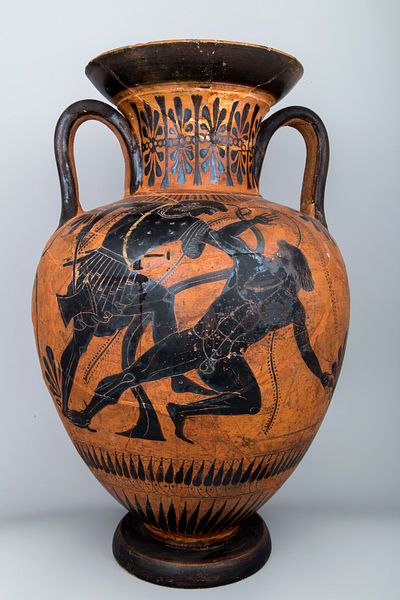
Epigrams
The Epigrams, originally inscribed in stone or on votive offerings, are easily among the works Callimachus is best known for in the modern era as the Heraclitus Epigram of Callimachus was part of the curriculum of schools in the United Kingdom and United States up through the mid-20th century. The epigram reads:
One told me, Heraclitus, of thy death and brought me to tears
And I remembered how often we two in talking put the sun to rest.
Thou, methinks, Halicarnasian friend, art ashes long and long ago
But thy nightingales live still, whereon Hades, snatcher of all things,
Shall not lay his hand.(A.W. Mair translation, Epigrams)
The poem was written for Callimachus' friend Heraclitus of Halicarnassus (l. 3rd century BCE) a poet famous for his volume of verse, Nightingales. Callimachus comforts himself in his epigram in the thought that, although his friend is dead, his poetry lives on and so, then, will his name. Sadly, none of the works of Heraclitus of Halicarnassus have survived except a single epigram. His name, and the title of his book, have only been preserved by Callimachus' poem.
Hymns
The six surviving hymns of Callimachus are:
Scholars continue to debate whether the hymns were written for recitation at public religious ceremonies and festivals or were purely literary creations. The difficulty in determining the hymns' purpose lies in Callimachus' careful crafting of each as though it were, in fact, an invocation at the beginning of a religious ceremony. It is possible, however, that he was only mirroring the style of such works to create something new. The opening of the Hymn to Apollo, for example, begins:
How the laurel branch of Apollo trembles! How trembles all the shrine! Away, away, he that is sinful! Now surely Phoebus knocketh at the door with his beautiful foot. See'st thou not? The Delian palm nods pleasantly of a sudden and the swan in the air sings sweetly. Of yourselves now, ye bolts, be pushed back, pushed back of yourselves, ye bars! The god is no longer far away. And ye, young men, prepare ye for song and for the dance.
(A.W. Mair translation, Hymns)
The work sounds like an invocation to be read at the opening ceremonies of a religious festival – and may have been – but scholars believe the details throughout the piece resonate on a more literary level.
Iambs
The Iambs of Callimachus were influenced by the works of the iambic poet Hipponax of Ephesus (l. 6th century BCE), famous for his satirical verse and attacks on the pretension of his contemporaries. Iambic poetry was originally defined by insulting language placed in the mouth of a fictional speaker or of a fictionalized version of the poet. The works of Hipponax – and later of Callimachus – explain some aspect of life while subtly (or directly) leveling some criticism at an individual, mode of behavior, school of thought, or the human condition in general.
In Callimachus' Iambus I, Hipponax comes back from the dead to criticize the poets and scholars of Callimachus' day for their foolish rivalries and pretension. In this, the Hipponax figure serves as the mouthpiece for Callimachus' own criticisms of his contemporaries. In Iambus II, a fictional speaker relates how animals were given the power of speech by the gods until the swan complained about mortality and the fox began whining over the injustice of Zeus. In response, Zeus takes away their power of speech and gives it to humans, which is why some people sound like animals.
Conclusion
Callimachus may have been influenced by Hipponax, and others, but made each genre he wrote in his own by simplifying the language and meter of the verse. Regarding the oft-repeated claim that he rejected Homer, Acosta-Hughes and Stephens argue that he never objected to the length of a work like the Iliad, per se, but to the long hexameter verse which no longer resonated with an audience because it had become static. Acosta-Hughes and Stephens write:
In Callimachus' day, Homer's ubiquity, from the schoolroom to civic performance, and his Panhellenic iconicity, limited his efficacy for creative imitation. Homer was an artifact, a monument of the poetic past, and inimitable, because the very monumentality of his texts guaranteed second-tier status for anyone who tried. The challenge for Callimachus and his peers was how to adapt Homer to a new environment, and this necessarily included "rejecting", if by that term we mean neither privileging nor imitating those aspects of earlier hexametric poetry that could not be translated effectively into contemporary writing. Callimachus clearly did not privilege the writing of a sustained narrative over many thousands of lines, the kind of narrative trajectory we find in the Iliad. (18-19)
Instead, Callimachus focused on presenting an audience with an immediate experience even in longer works such as the Aetia and Hecale. The literary aesthetic which has come to be known as Callimacheanism advocated for brevity, arguing that poetry was the use of refined language to produce a specific effect on an audience and such language could not be sustained in a long work. In this, Callimachus was advancing the same aesthetic later advocated in the 20th century by the poet Ezra Pound and writer Ernest Hemingway, among others, that the old styles and forms of literature could no longer speak to the present generation and literary works needed to be stripped of any unnecessary words or trappings. Scholar R. W. Livingstone, addressing the ancient Greeks, could as easily be writing about the literary revolutionaries of Paris in the 1920s:
Brevity indeed is not always simplicity, and it is possible to be at once simple and lengthy. But anyone who examines these Greek writers will find that they are brief, because, by avoiding bypaths and by-plots, elaboration or minute detail, they strike out the central features of their picture with an effortless economy of line. (254)
This observation applies to Callimachus as well, or better, than many other ancient Greek writers. In his insistence on simplicity of form and expression, Callimachus purified the literature of his time. He insisted a writer should "keep the muse slender" in producing works of restraint and discretion rather than the epic mode of inclusion of detail. His literary vision would influence the greatest Roman writers and, through them, the development of Western literature up through the modern era when literary forms were again challenged, broken, and made into something new.

